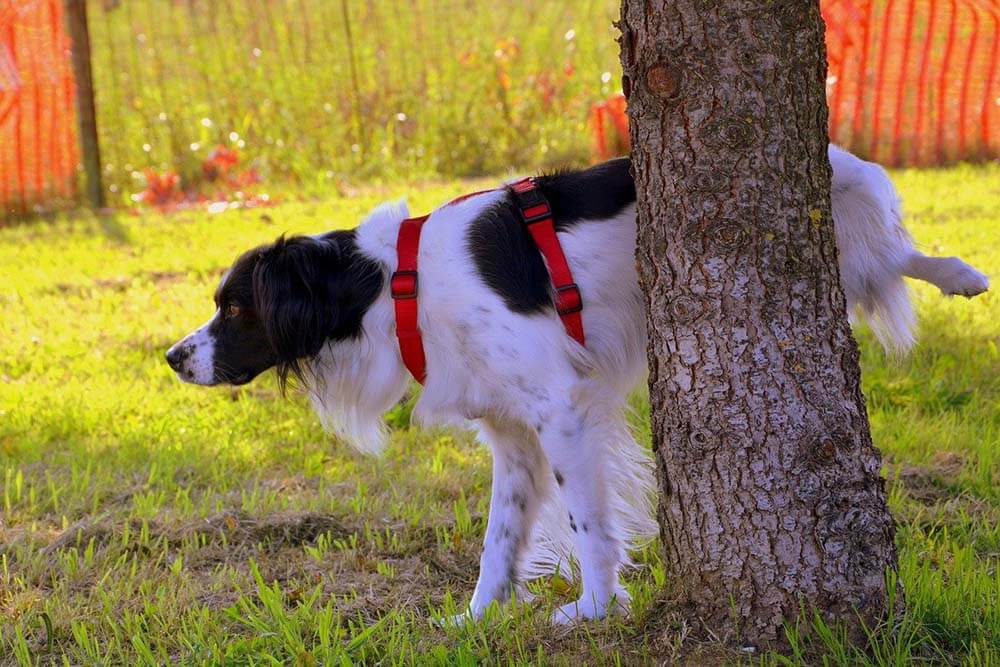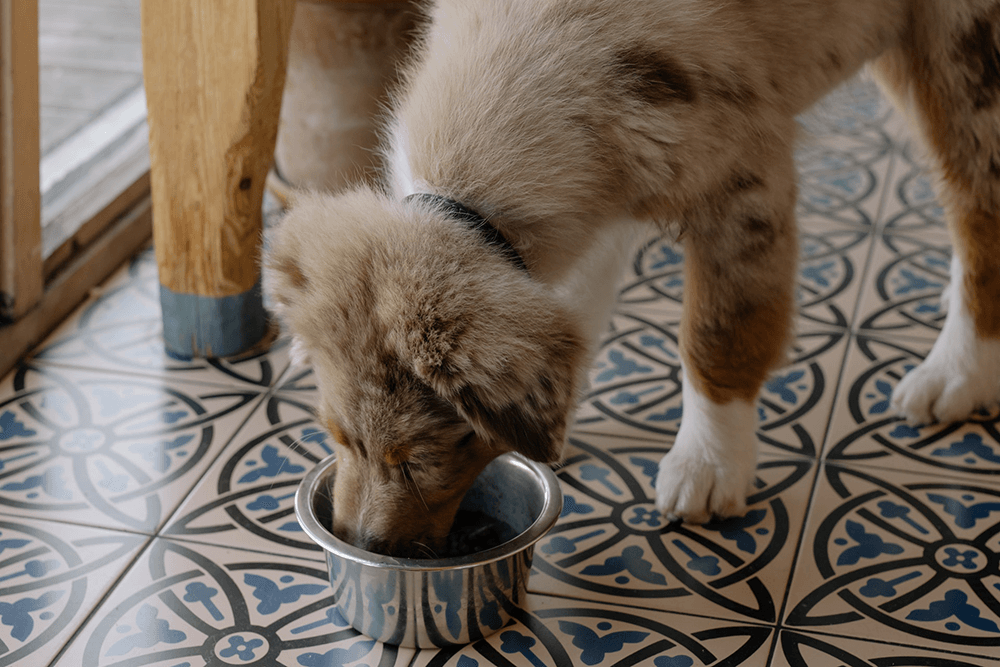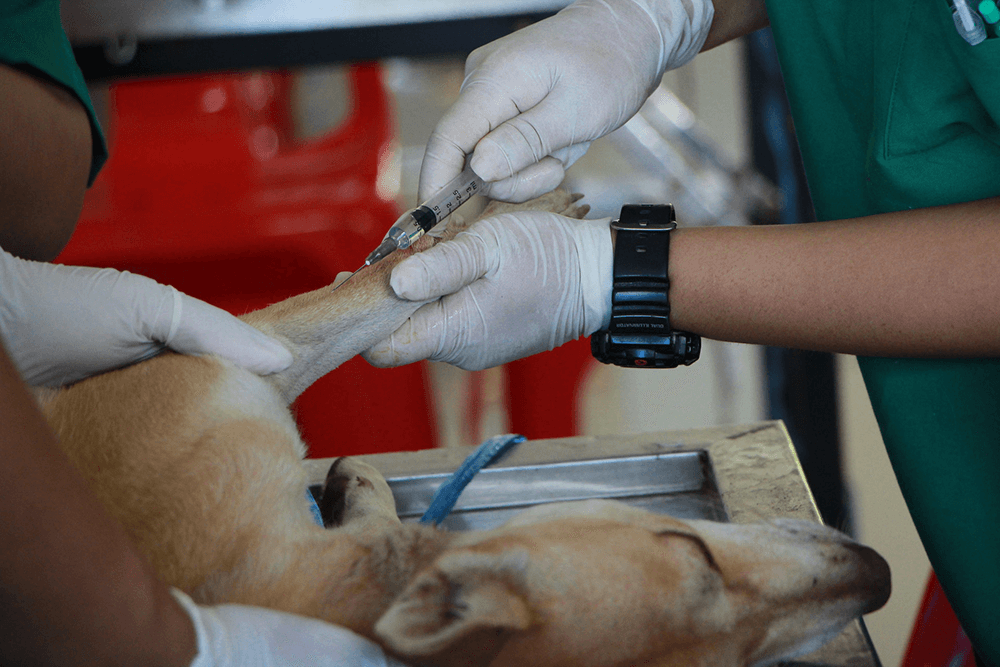We usually think of bladder stones as a human problem. The fact is, urinary bladder stones can occur in dogs, too.
Bladder stones (a.k.a. urinary stones, cystic calculi, or uroliths) are minerals in urine that have clustered together to form a hardened mass in the bladder. As their name suggests, these crystallized clumps look like stones.
Dogs may pass small bladder stones on their own through urination. Large stones may need surgical removal. Without treatment, bladder stones can cause serious, possibly deadly issues.

So how can you tell if your dog has bladder stones? Read on as we discuss canine bladder stone symptoms, causes, and other important information.
Bladder stones in dogs: symptoms to watch out for
Your dog may show no signs that they have urinary bladder stones. In many cases, however, the symptoms are similar to those of lower urinary tract disease.
One or more of the following symptoms may indicate your dog has bladder stones and/or related concerns such as urinary stones and ureter stones:
- Bloody urine (hematuria)
- Discolored or cloudy urine
- Difficulty urinating (dysuria); your dog may have to strain to pee
- More frequent urination than usual; your dog may also pee in smaller amounts
- Accidental/inappropriate urination in your house
- Urine with a sharper odor than usual
- Excessive licking of the genital area
- Discomfort in the abdominal or kidney area
- Bloated stomach
- Vomiting
- Decreased appetite
- Lethargy; drop in energy level
- Exercise avoidance
If you observe any of the above symptoms, take your dog to the vet immediately. If left untreated, this condition is potentially life-threatening.
The dangers of bladder stones in dogs
A single bladder stone can cause various changes in your dog’s body resulting in the aforementioned symptoms.
It’s likely serious cases of bladder stones cause dogs pain; dogs experiencing any discomfort typically display reduced energy levels as well as a lack of interest in things they normally enjoy, such as eating and going for walks. They may also whine or even snarl if a painful area is touched or pressed.
Another clue that bladder stones are painful is the canine licking behavior. Licking induces the dog’s body to produce endorphins, which are chemicals that reduce pain and anxiety. If your dog is obsessively licking their privates, they’re possibly trying to manage pain in the area.
Hematuria occurs when bladder stones scrape the bladder’s inner walls; the resulting tissue irritation and damage lead to bleeding.
Dysuria can be explained by several issues. For example, the inner bladder lining or urethra may be swollen or inflamed. Large stones can also cause a blockage in the point where the bladder connects to the urethra. Even small stones can be a problem when they get lodged in the urethra to create an obstruction. These are called urethral stones.
Partial urinary obstruction makes peeing difficult. You may see your dog squatting or lifting a leg to pee, but instead of releasing a stream of pee, they only dribble out small amounts.
A complete obstruction makes urination impossible and is therefore extremely dangerous. Unable to exit your dog’s bladder, the pee accumulates and causes the bladder to grow in size until it splits open. A ruptured bladder can be deadly, but immediate emergency treatment can save your dog’s life.
Stones can also get stuck in the ureter, which is the section of the urinary tract that conveys urine from the kidney to the bladder. A blockage in the ureter can damage your dog’s kidney, which can also prove fatal.

Diagnosis
Bringing your dog to the vet will allow them to determine whether or not your pooch has bladder stones, and what type of bladder stones they have.
Your vet will have your dog undergo a urinalysis and a blood test, and quite possibly an ECG, X-rays, ultrasound examination, and other tests.
These techniques are extremely effective in determining the reason behind your dog’s ailment. For instance, an ECG will detect heart rate abnormalities caused by a urinary blockage. X-rays can reveal the presence of most stones. Another method involves using a urinary catheter to introduce gas into the urinary tract, which can discover hard-to-find bladder stones.
Bladder stone types
Your vet’s diagnostic tools will determine what type of cystic calculi your dog has, and therefore the type of treatment they need.
Bladder stones in dogs come in a variety of types. The most common are struvite stones and calcium oxalate stones, which account for 85% of all cases.
Struvite stones
50% of all bladder stones in dogs are struvite stones. Struvite stone formation has everything to do with struvite crystals and certain bacteria, such as those responsible for urinary tract infection.
A natural component of canine urine, struvite crystals are composed of magnesium ammonium phosphate hexahydrate, a mineral commonly found in dogs. Struvite poses no inherent threat to your pet. However, when the urine becomes infected with bacteria whose enzymes make the urine less acidic, the struvite crystals become less able to dissolve in the urine. Struvite bladder stones form as a result.
This type of bladder stone is usually associated with urinary tract infections. It is most common in breeds such as the Labrador Retriever, Cocker Spaniel, Dachshund, Shih Tzu, Miniature Poodle, Yorkshire Terrier, Bichon Frise, and Miniature Schnauzer. 85% of dogs that develop struvite stones are female dogs.
The cases of struvite bladder stones in dogs are on the decline.
Calcium oxalate stones
35% of bladder stones in dogs are calcium oxalate stones. The formation of these stones has a strong genetic component.
Nephrocalcin is a substance normally found in canine urine. Its purpose is to limit calcium oxalate stone formation. Certain dog breeds, however, may have inherited a tendency to produce abnormal nephrocalcin that is less capable of proper functioning. It’s also possible these bladder stones form due to a diet comprising a surplus of oxalates.
While any dog breed can develop calcium oxalate stones, the issue is most common in Miniature Poodles, Miniature Schnauzers, Shih Tzus, Bichon Frises, Yorkshire Terriers, Norfolk Terriers, Norwich Terriers, Lhasa Apsos, Pomeranians, and Keeshonds.
Calcium oxalate stones are more common in male dogs. Cases of calcium oxalate stones are also on the rise.
Other stones
Rarer types of stones can form in your dog’s urinary system.
Silicate stones may form due to the increased consumption of foods high in silicates. They affect German Shepherds, Labrador Retrievers, Golden Retrievers, and Old English Sheepdogs more than other breeds.
Urate stones form when ammonium biurate crystals are excreted in high amounts in dogs suffering from a portosystemic shunt. They are usually diagnosed in Dalmatians.
Cystine stones arise in acidic urine containing high levels of cystine. They are common in male Dachshunds aged 3 to 6.
Treating bladder stones
How a vet removes a dog’s bladder stones depends on the type of stone formation affecting them. The vet will likely combine several techniques, from non-surgical procedures to more invasive methods. They’ll also require your dog to undergo follow-up examinations to see how well they’re responding to the treatment.
Here are some of the most common treatments you can expect:
Therapeutic diet
In some cases, a dietary treatment is enough to restore your pet’s health. For instance, there are brands of canned food for dogs that are specifically formulated to make the urine more acidic, facilitate the dissolution of existing struvite bladder stones, and prevent further stones from forming. Hill’s Prescription Diet S/D, Purina Pro Plan Veterinary Diets UR Urinary, and Royal Canin Urinary SO are examples of such foods. Combining this special diet with an increased intake of water can also encourage stone dissolution.
The dietary dissolution of bladder stones is preferred when there’s little risk of the stones blocking the urinary tract. Dissolving struvite stones may take from 2 to 12 weeks. If the treatment fails to dissolve all the stones, your dog may have a mixture of bladder stone types, in which case the treatment plan will need adjusting.

Medication
As bacterial infections often play a key role in the formation of struvite bladder stones, your dog will have to take antibiotics, too.
Bacteria often become trapped between stones. When the struvite stones are dissolved, these bacteria spread in the bladder. Antibiotic therapy is designed to kill these remaining bacteria, preventing them from causing another infection.
Your dog will have to take these medications for the entire duration of their special diet.
Bladder drainage
Immediate emergency treatment is required when stones produce a total blockage. For example, if stones get stuck in the urethra, the resulting urinary obstruction may prevent your dog from emptying their bladder, leading to an increased risk of a lethal bladder rupture.
To drain the bladder, the vet may use a procedure known as cystocentesis. This involves piercing the abdominal wall with a needle that is then inserted into the bladder. A syringe connected to the needle sucks out the urine.
Non-surgical stone removal
Surgery isn’t always required to remove bladder stones.
For instance, in a technique called retrograde urohydropulsion, a urinary catheter is inserted into the bladder through the urethra to flush the stones out.
An instrument called a cystoscope can also remove small bladder and urethral stones.
Such techniques work best on small stones. They’re sometimes performed to obtain stone samples for examination.
Surgical removal
While a special diet can dissolve struvite stones, it doesn’t affect calcium oxalate, cystine, silicate, and urate stones. In addition, non-surgical techniques can’t flush out larger stones. These stones require removal via surgery.
Your vet’s chosen surgical method depends on where in the urinary system the stones have clustered. If the stones are in the bladder, for example, they’ll perform a cystotomy. Urethral stones are excised via a urethrotomy. Ureterotomy removes stones in the ureter. Nephrotomy removes kidney stones a.k.a. urate stones (though kidney stones can often be removed non-surgically).
A procedure known as urethrostomy makes a permanent opening in the urethra. This allows stones to bypass the urethra, which prevents further obstructions to the urine flow.

A less invasive method called laser lithotripsy has also proven effective in the removal of urinary stones. This uses laser technology and endoscopic tools (long, slim tubes inserted into the body via natural bodily orifices). No incisions need to be made; the entire procedure is performed via the urethra. Alternatively, a tiny incision may be made in the bladder. Laser fiber and endoscopic equipment are then inserted through said incision.
A pet that has undergone surgery will require a recovery period lasting several weeks. For your dog to heal successfully, you must limit their physical activities, especially during the first and second post-treatment weeks. Your dog may be required to wear a “cone of shame” to prevent them from accessing and possibly reopening their wound. Don’t be shocked if you find traces of blood in your dog’s urine; this is to be expected in the first two weeks after surgery.
If the treatment is successful, your dog’s energy levels and appetite will gradually return to normal. At any rate, pet owners are advised to closely monitor their dog following surgery.
How to prevent bladder stones
Whether or not your pooch has ever had urinary stones, there are measures you can take to prevent their formation.
Take your dog to the vet for a check-up at least once a year and keep an eye out for urinary stone symptoms.
Ensure your dog always has access to clean drinking water so they can flush out their bladder regularly. Equally important is a balanced, vet-approved diet that lowers the mineral content of your dog’s urine. Lots of water and the right foods will result in dilute urine in which calculi are less likely to develop. If you’re considering giving your dog supplements, consult a vet first; some supplements can result in an increased risk of stone formation.
Because urinary stones can stem from urinary tract infection, familiarize yourself with the clinical signs of these conditions as well as the various ways you can prevent them. Should symptoms arise, immediately consult a vet for treatment options.
Most bladder stones can reoccur in your dog. As such, dogs that have already had bladder stones may be required to observe therapeutic diets for life. They may also need to take maintenance medications.
In conclusion
Bladder stones in dogs are potentially life-threatening if left untreated; thankfully, the common signs that tell you they’ve formed in your beloved pooch are fairly easy to spot. Various treatments are also extremely effective in removing and preventing these stones.
So keep a close eye on your dog; if they display any symptoms of bladder stones, seek your vet’s help immediately.
